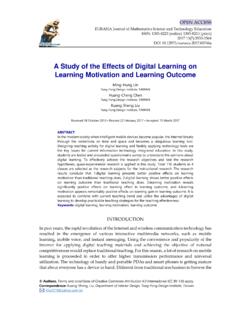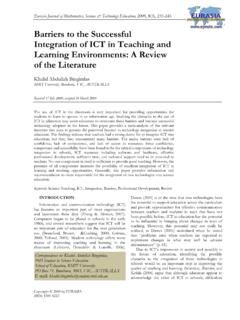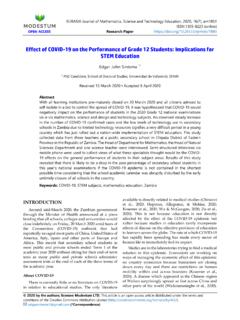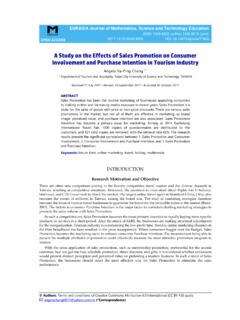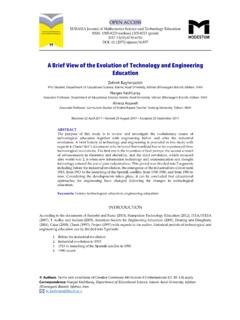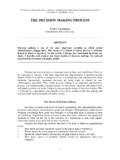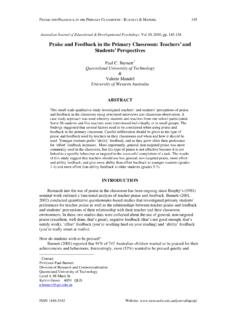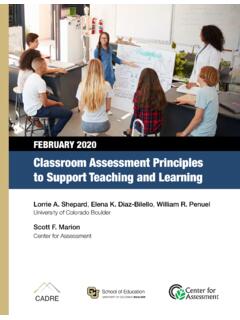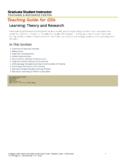Transcription of The Effectiveness of Teachers' Use of Demonstrations for ...
1 OPEN ACCESS EURASIA Journal of Mathematics Science and Technology Education ISSN: 1305-8223 (online) 1305-8215 (print) 2017 13(3):555-570 DOI Authors. Terms and conditions of Creative Commons Attribution International (CC BY ) apply. Correspondence: Muhamad Hugerat, The Academic Arab College for Education in Israel - Haifa, 22 Hahashmal st., 8349, 3108301 Haifa, Israel. The Effectiveness of Teachers' Use of Demonstrations for Enhancing Students' Understanding of and Attitudes to Learning the Oxidation-Reduction Concept Ahmad Basheer The Academic Arab College for Education in Israel - Haifa Muhamad Hugerat The Academic Arab College for Education in Israel - Haifa Naji Kortam The Academic Arab College for Education in Israel - Haifa Avi Hofstein The Academic Arab College for Education in Israel Haifa & Weizmann Institute of science, Israel Received 02 February 2016 Revised 14 July 2016 Accepted 26 July 2016 ABSTRACT In this study we explored whether the use of teachers' Demonstrations significantly improves students understanding of redox reactions compared with control group counterparts who were not exposed to the Demonstrations .
2 The sample consisted of 131 Israeli 8th graders in middle schools (junior high school). Students' attitudes and achievements as well as their understanding of redox and electrolysis were assessed by administering a questionnaire that investigated their attitudes (perceptions) towards a demonstration in chemistry. The findings showed that the experimental group's achievements and understanding of the subject were statistically significantly better than those of their control group counterparts. Keywords: chemistry Demonstrations , redox reactions, electrolysis, achievement, attitudes, electrochemical row, chemistry education INTRODUCTION Rationale for the Study The concept of oxidation-reduction is one of the key concepts taught and learned in chemistry in the middle school (junior high schools) in most countries around the world (GCE Ordinary Level). Butts and Smith (1987), for example, reported that high-school students found the concepts of electrolysis relatively difficult to understand.
3 In another study of 11th grade A. Basheer et al. 556 students conducted in Nigeria, Okpala and Onocha (1988) found that fifty percent of the students considered electrolysis one of the most difficult concepts. In a report by the Cambridge University Local Examination Union concerning the achievements of students from Singapore in GCE O Level chemistry exams, it was noted that concepts related to electrochemistry and electron transfer are associated with severe learning difficulties and with misconceptions (Tan, 2000). As mentioned before, oxidation-reduction is one of the most important concepts within the topic of chemical reactions taught in middle school. Gillespie (1997) stated that chemical reactions (including redox reactions) are one of the six key concepts in chemistry. Based on this premise, it was decided to investigate the learning and understanding of the concept by using classroom Demonstrations .
4 In this study we created a pedagogical intervention in order to help students better understand the concepts of oxidation-reduction and electrolysis, which are considered as difficult concepts in chemistry. The main goal of the current study was to investigate the educational Effectiveness of using Demonstrations in the context of teaching and learning the concept of oxidation-reduction in secondary school chemistry. More specifically, the main objectives of the current study are as follows: State of the literature Most of the studies on Demonstrations are general, namely, comparing students using experimentations with teachers' Demonstrations , covering a wide range of topics and concepts, less of these studies discuss the Effectiveness of Demonstrations . Few studies highlight that good Demonstrations can enhance students' understanding, motivation, and attitudes. Demonstration in chemistry may be defined as a pedagogical event whose objective is to illustrate a scientific concept.
5 The literature state that high percent of the students considered oxidation-reduction and electrolysis is one of the most difficult concepts. Contribution of this paper to the literature This study concentrates on demonstration's effect on students' achievements and attitudes in a special sector "the Arab sector in Israel". Increasing the spectrum of studies on Demonstrations in the redox and electrolysis reactions in which support the literature that well planned properly Demonstrations lead to improvement in the achievements and efficiency students. Based on students interview results, demonstration affected them very positively, brought these redox concepts closer to their hearts, increased the extent of interest and attractiveness, and increase their level of motivation and satisfaction. Hence, it can serve as an effective platform for enhancing students understanding of certain chemistry concepts. EURASIA J math Sci and Tech Ed 557 To explore the Effectiveness of Demonstrations regarding students' understanding of the oxidation reduction concept; To explore whether Demonstrations improve students' attitudes toward chemistry and increase their motivation to learn science.
6 THEORETICAL BACKGROUND The issue of using Demonstrations (to be defined later) in a chemistry classroom has often been discussed in the research literature (Hofstein & Lunetta, 1984; Bare, & Andrews, 1999; Thompson & Soyibo, 2002). Among the questions posed in the literature, we found the following: Are Demonstrations as effective as individual students' experimentations? Do Demonstrations promote the understanding and internalization of scientific concepts? Can Demonstrations develop students' thinking skills? And what conditions are needed to make teachers' Demonstrations more effective than individual students' experimentations? Although lecture Demonstrations have been conducted in chemistry classrooms for a long time, little research exists that documents the frequency that such Demonstrations are employed or their effect on learners' motivation and performance (Price & Brooks, 2012; Odom & Bell, 2015).
7 Shakhashiri (1992) remarked that "Educators have often searched for various ways to teach science". The use of Demonstrations is one of numerous pedagogical interventions that have been adopted for enhancing students interest. Experiments and Demonstrations that confirm a physicochemical phenomenon such as illustrating chemical processes by light-sticks (Kuntzleman, Rohrer & Schultz, 2012) can be used to facilitate understanding certain chemical concepts, for example, acid-base reactions, redox reactions, fluorescence, quantum chemistry, and thermodynamics. A demonstration involves illustrating a point in a lecture or a lesson by means of something other than routine visual aids or other means of instruction. A demonstration in chemistry may be defined as a pedagogical event whose objective is to illustrate a scientific concept (Taylor, 1988). This definition can be broadened and divided into three categories: (1) Visual aids used in an unusual manner, for example, teachers and students using body movements to illustrate acid/base chemistry and oxidation/reduction; another example would be Lomax's (1994) kinetic class, in which movement is used to reinforce the concept of chemical transformations.
8 (2) Analogical Demonstrations , in which one uses a phenomenon whose behavior is similar in relevant aspects to that of the scientific concept under discussion. A good example of this would be the use of steel balls on the glass cover of a watch to illustrate the density of atoms in a pseudo-metallic structure. (3) Real experiments, which are the most common type of demonstration: Shakhashiri presents numerous examples in his five published books (1983, 1985, 1989, 1992 & 2011). According to Chiappetta and Koballa (2002) and Shakhashiri (1992), well prepared and properly presented Demonstrations have the potential to enhance students' understanding of chemistry concepts. Similarly, Hofstein and Lunetta (1982, 2004), in their comprehensive reviews, came to the conclusion that Demonstrations have the potential to enhance learning, motivation, and attitudes. A. Basheer et al. 558 Gardner (1978) suggested that Demonstrations may enable learners to evoke the wow experience.
9 This consequently can increase their curiosity and enhance their reasoning abilities. In addition, it may have an impact on students achievements (Gerber, Cavallo & Marek, 2001). Moreover, there are occasions in which teachers' Demonstrations are educationally more effective than are students' own experimentations (Hofstein & Lunetta, 2004, Lunetta, Hofstein & Clough, 2007). Although research on the Effectiveness of Demonstrations has been conducted since the early 1960s, most of the studies were general, namely, comparing students using experimentations with teachers' Demonstrations , covering a wide range of topics and concepts. A number of research papers reported clear benefits when Demonstrations are used for teaching the sciences. In a study on college introductory physics courses, Buncick, Betts, and Horgan (2001) found that Demonstrations encourage generalization because they promote active participation on the part of the students.
10 An elevated level of student attention and involvement in tasks has also been reported for Demonstrations carried out in high-school chemistry courses. For example, Meyar et al. (2003) have shown that Demonstrations encourage student involvement, since they are less teacher -oriented and give students an opportunity to produce questions and to become more active in the learning process. This in turn can motivate students to undertake an initial inquiry and also provides a learning opportunity, because it helps create mental links between new and previous learning. In addition, Meyar et al. reported that students can illustrate cognitive strategies by observing the teacher as he thinks out loud while doing the demonstration and as he formulates questions that lead to an explanation of the concepts in question. This may challenge students' preexisting understanding and can encourage perceptual understanding. The traditional teaching strategy of using a lecture-type approach may perhaps be favored by those students who are in favor of the didactic methods of learning and who are considered conscientious (Hofstein & Kempa, 1985; Kempa & Diaz, 1995).



